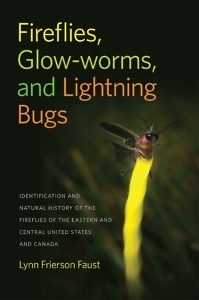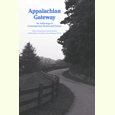A Glowing Review
Lynn Frierson Faust shares her passion for bioluminescent beetles—a.k.a. lightning bugs
In the preface to her elegant new guide, Fireflies, Glow-worms, and Lightning Bugs, Lynn Frierson Faust, an independent researcher known as “The Lightning Bug Lady,” tells the story of how she and the rest of a team of researchers arrived at the car-rental counter at the Knoxville airport. They were visiting the area to study a famous firefly display, and the rental clerk shared her own story of a family campout to experience the same thrilling beetles.  When the scientists asked why she was so interested in glow-in-the-dark beetles, Faust writes, “the car rental lady, pausing for a moment, her eyes with a dreamy, faraway look, replied, ‘I guess it’s for the awe of it.’”
When the scientists asked why she was so interested in glow-in-the-dark beetles, Faust writes, “the car rental lady, pausing for a moment, her eyes with a dreamy, faraway look, replied, ‘I guess it’s for the awe of it.’”
In this spirit of awe, Faust has given a true gift to amateur naturalists, backyard curiosity-seekers, and anyone else with an interest in these friendly, glowing creatures. This book, the first-ever comprehensive firefly guide to eastern and central North American species, is in many ways a field guide. But it’s also more than that—lavish with extras and organized in beginner-friendly fashion. Faust’s goal, she writes, is “to bring out the inner naturalist in each of you.” The passion, conversational style, and exhaustive knowledge make the book appropriate for just about anyone, while its scope and level of detail qualifies it as a definitive guide for even an expert firefly-hunter.
The book opens with a starter guide to identifying these insects, a survey of fireflies around the world, information about their life cycle, and a chapter called “Fieldwork, Research, and Filming.” But the bulk of book is devoted to “Species Accounts by Genus,” where users will find, for each species, a quick guide to identification, a description of its appearance, a description of flash behaviors, tips on the best times to find them and where, references to similar species, information about past research, personal research notes from the author, and lots and lots of gorgeous photos.
 Faust’s language and tone are far more accessible than that of a typical field guide, and a glossary helps smooth the user experience for the less natural-scientifically-literate. In the front of the book is a fold-out flash pattern chart—the first of its kind—to aid in identification. The back matter includes a bibliography, a list of online resources, and a subject index.
Faust’s language and tone are far more accessible than that of a typical field guide, and a glossary helps smooth the user experience for the less natural-scientifically-literate. In the front of the book is a fold-out flash pattern chart—the first of its kind—to aid in identification. The back matter includes a bibliography, a list of online resources, and a subject index.
Because they are common, non-invasive, and not poisonous or scary, Faust writes, “fireflies make especially good ambassadors for creating a deeper understanding of all insects and the place we all share in our natural world.” With her practical firefly-hunting advice, anyone can begin to explore this bioluminescent world for themselves. But no matter how much you come to love and respect these flashy critters, Faust has some unexpected advice: “Please do not forbid children that lifelong pleasurable, wondrous memory of catching fireflies on a warm summer’s evening and putting them in a jar. It would be nice, however, to encourage the children to release the fireflies back to the original site once they have enjoyed them and before bedtime.”

Kathryn Justice Leache is a freelance writer who lives with her family in her hometown of Memphis. Her life among books has included work as a librarian and stints as a bookseller at Square Books in Oxford, Mississippi, and The Booksellers at Laurelwood in Memphis.


